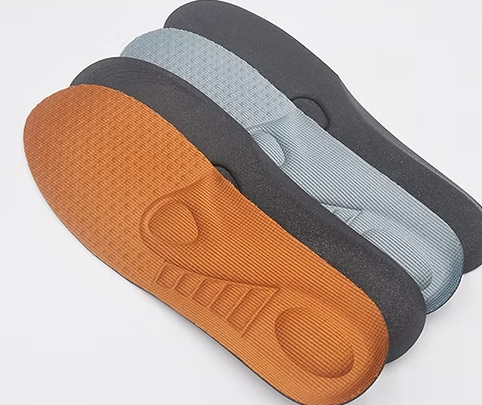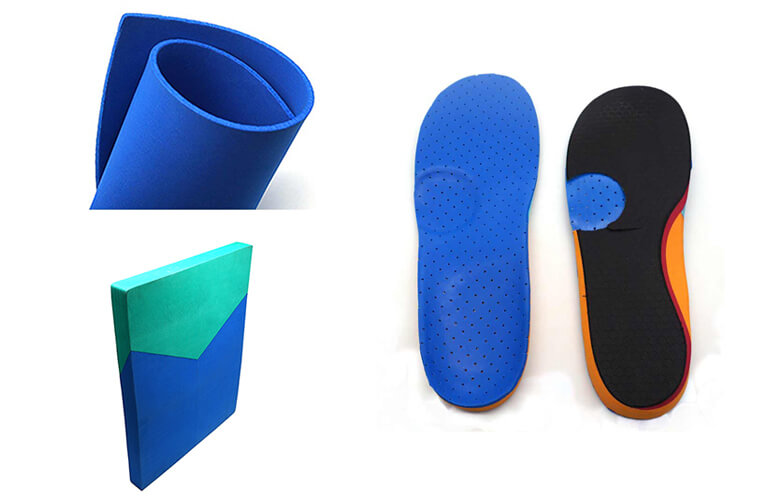










Content Menu
● The Basics: What Are Shoe Insoles?
● Key Functions of Shoe Insoles
>> 1. Cushioning and Shock Absorption
>> 2. Arch Support and Weight Distribution
>> 3. Enhanced Stability and Alignment
>> 4. Moisture Control and Odor Prevention
● Benefits of Using Shoe Insoles
>> 1. Better Comfort and Reduced Fatigue
>> 2. Pain Prevention and Relief
>> 3. Enhanced Posture and Body Balance
>> 4. Improved Athletic Performance
>> 6. Temperature and Moisture Regulation
● How to Choose the Right Shoe Insoles
>> 2. Match Insoles with Activity Level
>> 5. Consider Special Conditions
● Maintenance Tips for Shoe Insoles
● How Our OEM Insoles Help International Brands Succeed
>> Advantages of Our OEM Service
● FAQ
>> 1. Are shoe insoles removable and washable?
>> 2. How often should I replace my insoles?
>> 3. Can insoles help with flat feet?
>> 4. Do insoles make shoes feel tighter?
>> 5. Can I use the same insoles in different shoes?
Shoe insoles may seem like a small part of footwear, but they play an enormous role in enhancing comfort, performance, and foot health. Whether you're an athlete striving for better performance, a worker who spends hours on your feet, or simply someone who values comfort in daily life, understanding what insoles do can help you make better choices to protect and support your feet. This comprehensive guide explores the functions of insoles, their types, benefits, and how to choose the right insole for your needs. It also highlights how a professional OEM manufacturer can deliver custom solutions for global brands.

Shoe insoles, also known as footbeds or inner soles, are removable or built-in layers that rest inside shoes, offering support and cushioning to the feet. They act as an interface between the bottom of your feet and the shoe's midsole, creating a stable and comfortable environment. While some insoles are designed for orthopedic or athletic purposes, others focus on comfort, hygiene, or posture correction.
Made from materials such as EVA foam, polyurethane (PU), gel, leather, or memory foam, insoles can be either flat or contoured, depending on the user's needs. The right insole can transform an ordinary pair of shoes into a supportive and health-boosting tool that enhances posture and prevents injuries.
Every step produces impact forces that travel through your feet to your knees, hips, and spine. Insoles cushion these shocks and soften the stress your feet endure daily. Quality foam or gel insoles are particularly effective for runners or individuals who walk long distances, absorbing impact and preventing joint strain.
Insoles support the natural curve of your foot, known as the arch. Proper arch support assists in even weight distribution, reducing fatigue and discomfort. High arches, flat feet, or flexible arches benefit differently from various designs. Correct arch support helps maintain stable foot alignment and prevents pain from conditions like plantar fasciitis.
A well-designed insole stabilizes your foot movements, preventing unwanted rolling in or out (overpronation or supination). This improved alignment leads to better posture, reduced back pain, and more efficient walking or running mechanics.
Sweat accumulation inside shoes can create bacterial growth and odor. Many insoles include moisture-wicking and anti-bacterial layers that absorb perspiration and keep your feet dry. This contributes significantly to foot hygiene, especially for people wearing shoes for extended periods.
High-quality insoles help distribute pressure across the entire surface of the foot, minimizing discomfort caused by standing or walking for long hours. This is especially beneficial for those with heel spurs, calluses, or diabetic foot sensitivity, as it helps protect delicate tissues and nerves.
Different lifestyles and needs call for different types of insoles. Understanding these categories can help you find the perfect fit.
These insoles focus primarily on cushioning and softness. They are often made of foam or gel and are suitable for people seeking added comfort in casual or business shoes. They reduce fatigue, especially in workers who stand for many hours.
Supportive insoles reinforce structural stability rather than soft cushioning. They offer firm arch and heel support and are ideal for individuals with overpronation, flat feet, or arch pain. Such insoles provide balance and long-term posture correction.
Designed for medical or corrective purposes, orthotic insoles promote natural foot alignment and alleviate chronic pain. They are often custom-molded based on podiatric analysis. Medical-grade orthotics address foot deformities, reduce stress injuries, and improve overall gait performance.
These are engineered for athletes and active individuals. Sports insoles deliver advanced shock absorption, energy return, and stability, reducing the risk of injury during running, cycling, and hiking. They promote endurance and improve athletic performance.
Custom insoles are tailored based on foot measurements or 3D scans. They provide precise arch support and comfort, solving unique biomechanical problems. Custom options are often recommended for people with pronation issues or specific orthopedic needs.
By cushioning every step, insoles help minimize fatigue, especially when walking or standing for long durations. They transform shoes into comfort-enhancing gear suitable for long workdays or travel.
Foot, ankle, and knee pain often result from improper pressure distribution or poor shoe support. Insoles correct these imbalances by aligning the body and preventing excessive strain.
Proper alignment of the feet contributes directly to spine and hip alignment. Insoles anchor your foundation, promoting a healthier posture and reducing systemic body strain.
Sports enthusiasts gain better foot control, energy efficiency, and shock resistance. High-performance insoles enable athletes to train longer with less risk of injury.
By acting as a barrier between your foot and the shoe's insole bed, an added insole reduces interior wear, preserving the structural integrity of the shoe for longer use.
Breathable insoles provide temperature control by circulating air, keeping feet cool in summer and insulated in colder months. This feature adds comfort while preventing odor and blisters.

Understanding your foot shape is essential.
- Flat feet: Require rigid arch support to prevent inward rolling.
- Normal arches: Need medium support for balanced pressure.
- High arches: Benefit from flexible and cushioned insoles.
A simple wet footprint test can help reveal your arch type.
Each activity type demands specific performance features:
- For running or high-impact exercise: choose cushioned and shock-absorbing insoles.
- For hiking: choose durable insoles with reinforced heels.
- For office or daily wear: select breathable, antibacterial foam designs.
The material determines comfort, durability, and breathability.
- EVA foam: Lightweight and flexible; ideal for everyday comfort.
- Gel: Superior shock absorption; excellent for heavy impact activities.
- PU foam: Highly resilient and supportive; used in orthotic designs.
- Memory foam: Provides personalized support and comfort.
- Leather: Naturally breathable and long-lasting; preferred for formal shoes.
Some insoles are trim-to-fit, allowing users to cut them to match shoe size. Others are available in fixed sizes or custom molds. Ensure that the insole fits snugly without crowding your toes.
People with foot problems such as plantar fasciitis, bunions, or arthritis should seek medical or orthopedic recommendations for insoles designed to relieve specific pain points.
- Regular Airing: Remove your insoles after wearing and let them dry overnight.
- Cleaning: Hand wash gently with mild soap and water, then air dry completely.
- No Heat Exposure: Avoid drying near heaters or in direct sunlight.
- Replacement Routine: Replace insoles every 6 to 12 months or at the first signs of wear or odor.
Proper care ensures long-lasting hygiene and comfort while extending the product's effectiveness.
As one of China's leading shoe insole manufacturers, we specialize in OEM and ODM services for global footwear brands, wholesalers, and manufacturers. Our factory integrates advanced production equipment, from precision cutting to automated forming and laser engraving, ensuring superior design accuracy and consistent quality. We produce comfortable, orthopedic, and sport-targeted insoles that meet international standards and align with each client's branding goals.
- Professional R&D Capability: Our experienced team assists clients in research, material testing, and ergonomic modeling.
- Comprehensive Material Selection: Including EVA, PU, natural latex, and gel for comfort and functionality.
- Customization Options: Custom shape, thickness, hardness, color, and private logo printing.
- Strict Quality Inspection: Each insole undergoes compression, flexibility, and durability testing.
- Eco-Friendly Manufacturing: We prioritize recyclable and sustainable materials to support green production.
By cooperating with major footwear brands from Europe, North America, and Asia, we have helped design insoles for various sectors—sportswear, safety shoes, medical shoes, and casual footwear. Our engineering expertise and OEM flexibility make us a reliable partner for clients seeking both quality and scalability.
Shoe insoles are far more than simple padding—they are vital components that safeguard your feet from daily impact, correct alignment, and promote overall body health. With proper selection and regular maintenance, insoles can transform ordinary shoes into highly comfortable and supportive footwear. Whether you're an athlete striving for performance gains or a worker seeking all-day comfort, investing in quality insoles can significantly enhance life quality. For brands and distributors, collaborating with a professional Chinese OEM manufacturer ensures access to advanced materials, innovative designs, and dependable production capacity, enabling high-end foot comfort products for the global market.

Yes, most insoles are removable. You can clean them with mild soap and water, then air dry them away from heat sources. Keeping them clean helps maintain comfort and hygiene.
You should replace your insoles every 6 to 12 months, depending on how often you wear them. If they lose their shape or no longer cushion properly, it's time for replacement.
Absolutely. Insoles with strong arch support relieve discomfort by distributing pressure evenly and preventing overpronation, common in people with flat feet.
They can, especially if the shoes originally lacked removable insoles. To avoid tightness, use thinner insoles or remove the original footbeds before inserting new ones.
Yes, removable insoles can be interchanged among shoes with similar shapes and sizes. However, using them in multiple shoes can accelerate wear and reduce lifespan.